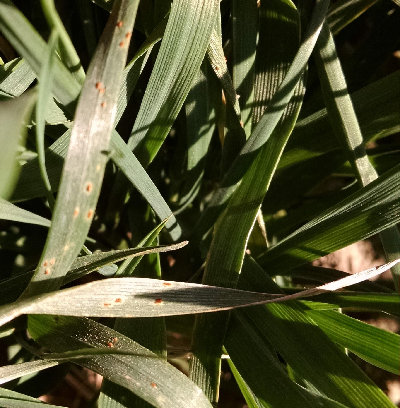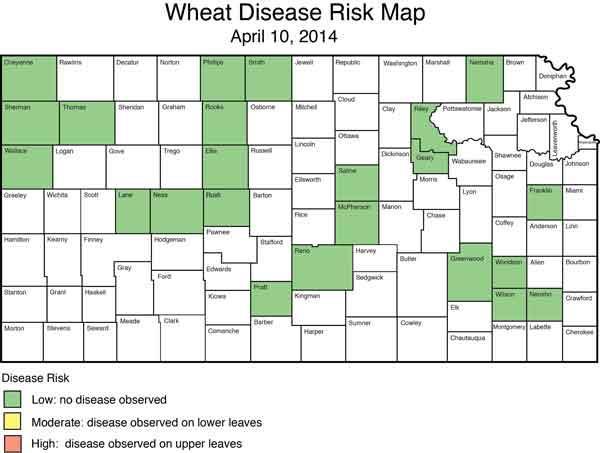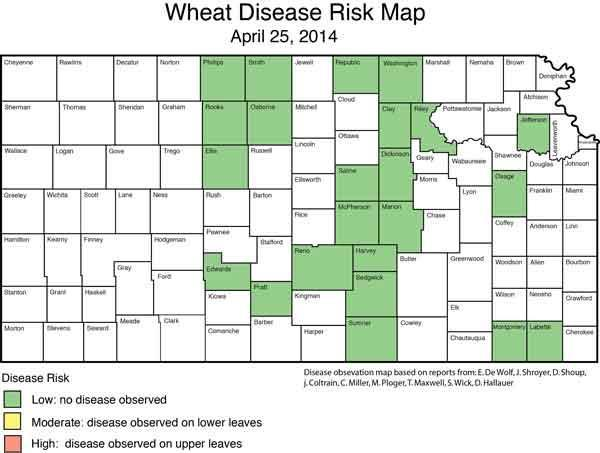2014 Wheat Disease Updates
Leaf Rust Update (10/29/14)
I have been finding a small amount of leaf rust in wheat fields in the last couple weeks. I have attached a picture of what I am finding. You will notice that it is showing up on the older leaves of the plants. It is not uncommon to find leaf rust in the fall and this fall has been especially conducive to the development of the disease. Leaf rust loves the weather that we have been having...with dew and fog in the mornings and highs between 65 – 80 degrees.
Nearly 60% of the time in Kansas, leaf rust does not survive the winter because of the cold temperatures and leaf dessication. Generally, leaf rust does not survive the winter in northwest Kansas.
Also, fungicide treatments are not recommended in the fall. Fall infections are generally light infections and do not cause yield losses.

-Jeanne Falk Jones, K-State Multi-County Agronomist
Wheat Disease Update (May 16, 2014)
There has been no stripe, leaf or stem rust reported in Kansas or in the panhandle of Oklahoma. In far northwest Kansas, the wheat's stage of growth ranges from the flag leaf nearly fully emerged to beginning heading. This is the typical time of fungicide applications. However, with no disease pressure, not applying fungicides this year is a sound business decision with less than 3% chance of a yield increase.
-Jeanne Falk Jones, K-State Multi-County Agronomist
Wheat Disease Update (May 9, 2014)
A note from Jeanne: there has been no rust found in Cheyenne, Sherman, Wallace, Rawlins or Thomas Counties, as of May 9.
The wheat crop has raced ahead in growth stages this past week. The growth stage now ranges from flag leaf emergence in the north to early stages of kernel development in the south.. The hot, dry weather continues to be the major issue in the state although spotty rains have brought some short-term relief to some limited areas of the state.
I have been scouting and participating in Extension programs in south central Kansas this week including Barber, Harper, Kingman, Pratt, and Reno counties. I found no leaf rust or stripe rust in these demonstration plots. Powdery mildew has been absent this year. I found trace levels of tan spot in a few fields on lower leaves. Other reports from Cheyenne, Jefferson, Nemaha, Osage Phillips, Saline, Sedgwick, Sherman, Sumner, Wallace counties indicate no disease in other areas of the state.
The risk of severe disease in Kansas remains very low this year.
-Erick De Wolf, K-State Extension Plant Pathology
Wheat Disease Update (April 25, 2014)
A note from Jeanne: There has been no rust (stripe, leaf or stem) found in Cheyenne, Sherman, or Wallace counties as of April 25.
The risk of severe leaf diseases remains low throughout Kansas. My own scouting and reports from K-State agronomists indicate that leaf rust and stripe rust are not present in the state. Tan spot, septoria, leaf blotch, and powdery mildew were absent in most fields; however, we did find a small number of fields with low levels of tan spot in Saline, McPherson, and Sedgewick counties. These fields all had wheat residue from previous crops on the soil surface. This residue is important because it often harbors the fungus that causes tan spot.
Drought stress was evident in most fields and the dry conditions are holding disease in check for now. Recent rains have brought some temporary relief to the dry conditions in a few areas of the state. We will continue monitoring the disease situation as this moisture may stimulate some disease. The symptoms of any new infections would not become evident for 7-10 days. The current risk of severe disease in Kansas and the need for foliar fungicides is low.

Summary of disease conditions in other states:
Texas has reported some stripe rust activity just south of Dallas but warm temperatures have slowed the progress of that disease. Bob Bowden, USDA Plant Pathologist, reports that leaf rust remains active in research plots near San Antonio, Texas. However, the disease remains at low levels in commercial fields according to Tom Isakeit, Extension Plant Pathologist for Texas A&M. Wheat fields in southern Texas are nearly ready for harvest. The trace levels of rust reported in central Texas have not advanced to cause problems in that area according to Ron French, Extension Plant Pathologist for Texas A&M. Rust has not spread into key wheat production areas of northern Texas.
In Oklahoma, Bob Hunger, Extension Plant Pathologist for OSU, indicates that leaf rust and stripe rust have not been found in Oklahoma yet this season. Conditions remain dry in Oklahoma and they are currently evaluating fields for evidence of freeze injury that occurred on April 15.
-Erick De Wolf, K-State Extension Plant Pathology
Wheat Disease Update (April 10, 2014)
The growth stage of wheat in Kansas ranges from tillering in the northwest to jointing in the southeast and south central regions of the state. The development of the crop is 2-3 weeks behind schedule for this time of year. Dry soil conditions and thin stands continue to threaten yield potential and remain the primary concern for many wheat growers in Kansas.
Wheat leaf rust and stripe rust update
There are no reports of leaf rust, stripe rust, or stem rust to date in Kansas (figure below). Dry conditions appear to be holding rust and other fungal diseases in check in Kansas for now. Wheat soilborne mosaic was reported in a few fields in south central Kansas and in research plots near Manhattan. The symptoms of this disease often fade quickly as temperatures warm. Only trace levels of powdery mildew and tan spot have been reported to date in Kansas.

Reports from other states
Oklahoma. Bob Hunger, Extension plant pathologist for Oklahoma State University, reports that rust has not been reported in Oklahoma to date. He reports that low levels of powdery mildew and tan spot were present in some fields.
Texas. In Texas, Amir Ibrahim, Texas A&M wheat breeder, reports that leaf rust and stripe rust continued to develop in irrigated research plots near San Antonio. He noted that the races of stripe rust able to overcome the Yr17 resistance present in many varieties with a Jagger pedigree (Fuller, Overly, Jagalene, PostRock) were rare to absent. Ron French, Texas A&M Extension plant pathologist, reports that rust was not present in commercial fields in north central Texas. However, he mentioned that stripe rust and leaf rust were present in commercial wheat fields south of Dallas in Waxahachie (Ellis County) and in Bastrop and Travis counties, which are east of Austin. He reports that Greer and Cedar were being affected by leaf rust. French indicates that temperature and moisture conditions in the Texas High Plains are not conducive for major disease epidemic.
Take home message
The current status of disease and dry weather suggests the risk of severe fungal diseases is currently low in Kansas. Clearly, the crop has a long way to go at this time. The delayed growth and development of the crop may increase the chances that leaf rust could arrive in time to cause damage.
Producers should keep an eye on what is happening in Texas and Oklahoma. Locally, producers should be checking their fields for symptoms of disease more frequently as the crop approaches flag leaf emergence.
-Erick De Wolf, K-State Extension Plant Pathology
Wheat Disease Update (March 31,2014)
This is just a quick update on the wheat disease situation in Kansas. All remains quiet in Kansas and I think winter kill and lack of moisture remain the primary issue on growers' minds.
There was an update from Texas late last week that we should discuss. This report indicates that stripe rust has increased in some research plots near San Antonio, but that they were expecting the progress of the disease to slow because of warmer temps in Texas. They were reporting disease on TAM 111, which suggests that the 2012 races were present (able to cause disease on Everest, Armour, and TAM 111). Leaf rust was also present, but appears to be restricted to the lower canopy at this point.
Oklahoma has not reported rust so far in 2014 and is concerned about drought and brown wheat mite.
My take on this is that the risk of severe disease in Kansas is still low.
-Erick De Wolf, K-State Extension Plant Pathologist
Outlook for Wheat Rust in Kansas
Here is the projection of the risk of leaf rust and stripe rust in KS for 2014 based reports of disease and weather information throughout the Southern Great Plains to date.
Regional reports of disease: The years with several leaf rust and stripe rust epidemics in Kansas are often preceded by outbreaks of disease in Texas and Oklahoma. The first indications of problems often occur in Texas during February and March. So far, our colleagues in Texas and Oklahoma are reporting that leaf rust and stripe rust are absent or at low levels relative to recent years. However, there are a few spots in Texas that we will want to keep an eye on. Below are a few highlights.
Amir Ibrahim, wheat breeder for Texas A&M, reported both leaf rust and stripe rust in susceptible varieties in this irrigated field near San Antonio. This report indicates leaf rust has been slower to develop at this location than in previous years. A single focus of stripe rust was also reported at this location.
Tom Isakeit, Extension Plant Pathologist for Texas A&M, shared an unconfirmed report of leaf rust and stripe rust near Warton, TX (about an hour South of Houston). Tom indicates that this area of TX has little commercial wheat production. The isolation of this field may reduce risk of disease spread. Amir and Tom both indicate that wheat was ranged from late jointing through flag leaf emergence stages of growth.
Charlie Rush and Ron French, Texas A&M Amarillo, indicate that dry conditions still dominate in the panhandle region of TX and that there are no reports of rust to date.
Bob Hunger, Oklahoma State Univ. wheat pathologist, indicates that there are no reports of rust in OK so far this season, and that cold, dry weather conditions have not favored foliar diseases in OK.
In Kansas, the wheat has been emerging from winter dormancy over the past two weeks. There have been no reports of leaf rust or stripe rust so far in 2014. As you may recall, leaf rust was reported last fall near Manhattan, KS. I revisited these fields today and was unable to find the disease suggesting tha the leaf rust did not overwinter. In recent weeks, I also visited fields near Garden City (SW Kansas), Great Bend and Hutchinson (both in central Kansas). There was no evidence of disease in the fields I checked.
Assessment based on weather: Researchers here at KSU have been evaluating the weather conditions associated with historic epidemics of stripe rust in Kansas. This research indicates that stripe rust epidemics are most likely to occur when regional moisture conditions favor disease development in the fall (Oct-Dec) and winter months (Feb). Based on regional moisture in the fall and winter months in 2013-2014, it appears that the risk of severe stripe rust is low for Kansas.
The bottom line: My current evaluation of the regional disease reports and weather patterns indicate that the risk of severe leaf rust and stripe rust in KS is low. I will provide regular updates about the status of disease as the season progresses. So stay tuned, because disease situations can change rapidly.
-Erick DeWolf, Extension Plant Pathologist, Kansas State University
